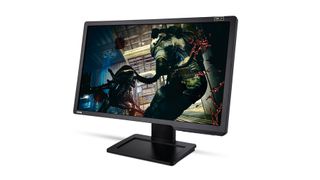Resolution revolution: why are desktops so late to the 4K party?
Eight million reasons to upscale
4K's good enough … for now
With a 4K panel, you're pumping four times the number of pixels for each frame, so to maintain frame rates, you need four times the graphics horsepower. That's very, very scary. We've done some reasonably extensive testing in this area, and our conclusion is that the video card that can cope with 4K has yet to be created. Not even the new Radeon R9 290 Series from AMD or GeForce GTX 780 Ti from Nvidia can handle the heat from the 4K kitchen.
Perhaps a trio of 780 Tis could do the trick, but the bottom line is that there's work to be done. But that's okay, because panels in the broader 2,560-pixel market are pretty bloody wonderful and halve the stress on you GPU compared with 4K.
Likewise, the one good thing about the relatively slow pace of change in the PC monitor market is that a high-res panel bought today is about as good a long-term investment as you can make. So, as Arnold Schwarzenegger says, do it. Do it now.
Super-smooth graphics
Last year saw the arrival of the first mainstream LCD monitors with super-high refresh rates beyond 120Hz. Now some manufacturers are flogging 240Hz panels. What's next for super-smooth graphics?
Nvidia recently pulled the wraps off a new technology known as G-Sync. The idea here is syncing the GPU with the display. This is possible to a degree already courtesy of v-sync settings in-game or via the graphics driver. The problem is, v-sync is a pretty blunt tool and only really works at certain refresh rate steppings.

It's a bit more complicated than that, but the mismatch inherent in a display with a fixed refresh rate being fed variable frame rates by a GPU means stuttering is usually going to creep in somewhere. The answer is to dynamically match the display refresh to the GPU's output, and that's exactly what G-Sync technology does.
The only slight snag is that it requires hardware built into the display, so you'll need to invest in a new monitor, which could be a deal-breaker. In better news, G-Sync works with any Nvidia GPU from the 650 Ti upwards.
Get daily insight, inspiration and deals in your inbox
Get the hottest deals available in your inbox plus news, reviews, opinion, analysis and more from the TechRadar team.
Overall, we welcome G-Sync, but we'll have to wait and see how widely the tech is adopted. It's not very much use if it limits your choice of monitor to a handful of compatible models. Another recent development is the advent of screens with so-called flicker-free backlights.
The supposed issue here are pulse-width modulated backlights that achieve variable brightness by rapidly switching the backlight on and off. Some manufacturers, including BenQ, claim this introduces flicker, but in our testing it's very difficult to spot any actual difference. Then again, maybe it's a bit like the rainbow effect with DLP monitors, and some people will be more sensitive to it than others. Try before you buy!
Contributor
Technology and cars. Increasingly the twain shall meet. Which is handy, because Jeremy (Twitter) is addicted to both. Long-time tech journalist, former editor of iCar magazine and incumbent car guru for T3 magazine, Jeremy reckons in-car technology is about to go thermonuclear. No, not exploding cars. That would be silly. And dangerous. But rather an explosive period of unprecedented innovation. Enjoy the ride.
